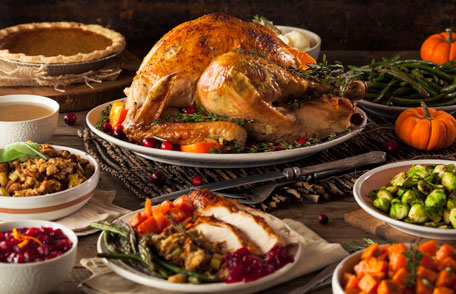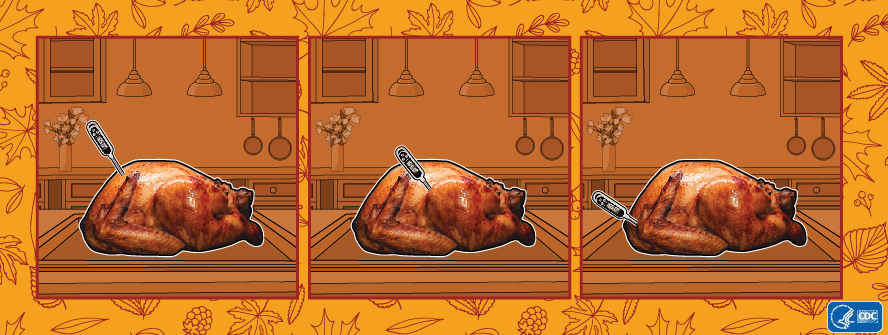At a glance
- Raw turkey can contain foodborne germs like Salmonella and Clostridium perfringens.
- Store, thaw, handle and cook turkey, stuffing, and leftovers properly to prevent food poisoning.

Why it's important
Turkey and its juice can be contaminated with germs that can make you and your family sick. Raw turkey can have Salmonella, Clostridium perfringens, Campylobacter, and other germs. Whether you're cooking a whole bird or a part of it, such as the breast, you should take special care to prevent food poisoning.
The bacteria Clostridium perfringens grows in cooked foods left at room temperature. It is the second most common bacterial cause of food poisoning. The major symptoms are vomiting and abdominal cramps within 6 to 24 hours after eating.
Clostridium perfringens outbreaks occur most often in November and December
Steps to take
Store turkey properly
Frozen raw turkey should be stored in the freezer until you are ready to thaw it. Make sure your freezer is at 0˚F or below. Don’t store a turkey in a place where you can’t closely monitor the temperature, such as in a car trunk, a basement, the back porch, or in snow.
Thaw turkey safely
Use one of the methods below to thaw your turkey.
In the refrigerator
Keep your turkey in its original wrapping and place it in a container before putting it in the refrigerator. The container will prevent the turkey juice from dripping on other food. Allow about 24 hours of thawing for each 4 to 5 pounds of turkey. A turkey thawed in the refrigerator can remain in the refrigerator once it's been thawed for 1 to 2 days before cooking.
In cold water
Be sure your turkey is in a leakproof plastic bag before you place it in the sink. The bag will prevent the turkey juice from spreading in the kitchen. The bag also will prevent the turkey from absorbing water, which could make your cooked turkey runny. Make sure to completely cover your turkey with cold tap water. Change the water every 30 minutes. Allow about 30 minutes of thawing for each pound of turkey. A turkey thawed in cold water must be cooked immediately after thawing.
In the microwave
Follow the microwave manufacturer’s instructions for thawing your turkey. A turkey thawed in the microwave must be cooked immediately after thawing.
Never thaw your turkey by leaving it out on the counter.
Handle turkey correctly
Raw turkey and its juice can contaminate anything they touch. Be sure to handle your turkey correctly to prevent harmful germs from spreading to other food or your family and friends.
- Wash your hands with soap and water for at least 20 seconds before and after handling turkey.
- Use one cutting board for raw turkey and a separate cutting board for produce, bread, and other foods that won't be cooked.
- Never place cooked food or fresh produce on a plate, cutting board, or other surface that held raw turkey.
- Wash cutting boards, utensils, dishes, and countertops with hot soapy water after preparing raw turkey and before you prepare the next item.
Cook stuffing thoroughly
It's safest to cook stuffing in a casserole dish instead of inside your turkey. Cooking stuffing in a casserole dish makes it easier to know the stuffing is thoroughly cooked. If you do cook stuffing inside the turkey, put the stuffing in the turkey just before cooking.
With either cooking method, use a food thermometer to make sure the stuffing's center reaches 165°F. Germs can survive in stuffing that has not reached 165°F. If you cooked the stuffing in your turkey, wait 20 minutes after taking the bird out of the oven before removing the stuffing. This allows the stuffing to cook a little longer.
Cook turkey thoroughly
To roast a turkey in your oven, set the oven temperature to at least 325°F. Place the completely thawed turkey in a roasting pan that is 2 to 2-1/2 inches deep. Cooking times depend on the weight of the turkey and whether it is stuffed.
Use a food thermometer to make sure your turkey has reached a safe internal temperature of 165°F. Check by inserting a food thermometer into three places, avoiding bone: thickest part of the breast; where body and thigh join, aiming toward thigh; and where body and wing join, aiming toward wing. Even if your turkey has a pop-up timer, you should still use a food thermometer to check that it is safely cooked.

If you stuffed your turkey, insert a food thermometer into the center of the stuffing to ensure it reaches 165°F. Remember to let the turkey stand 20 minutes before removing all stuffing and carving the meat. This will let the stuffing cook a little longer and make the turkey easier to carve.
If you are cooking your turkey using another method, such as smoking or frying it, or if you are roasting a turkey that is not fully thawed, follow these guidelines from USDA for cooking your bird safely.
Take care of leftovers
- Refrigerate leftovers at 40°F or colder within 2 hours of cooking to prevent food poisoning. Refrigerate leftovers that have been exposed to temperatures higher than 90°F, like in a hot car, within 1 hour.
- If you are refrigerating a big cut of meat, such as a turkey or roast, cut it into smaller pieces so they cool quickly. You do not need to wait until food is cool to store it in the refrigerator or freezer.
- Eat cooked turkey and dishes made with it, such as soup or a casserole, within 3 to 4 days. Freeze leftovers to store them for longer.
- Reheat all leftovers to at least 165°F before serving or eating.
Dangers of washing raw turkey
Washing raw turkey can spread germs to other food. Federal agencies have recommended not washing turkey or chicken since 2005. But a 2020 survey1 found that 78% of participants reported washing or rinsing turkey before cooking. Old recipes and family cooking traditions may tell you to keep this practice going, but it can make you and your family sick. Poultry juice can spread in the kitchen and contaminate other foods, utensils, and countertops.
If you decide to wash raw turkey, immediately clean and thoroughly sanitize the sink and surrounding area. A USDA study found that 1 in 7 people who cleaned their sink after washing chicken still had germs in the sink.
Resources
- Learn more about safe internal temperatures for other foods and how to use a food thermometer.
- USDA Recommendations for Thawing Turkey
- *Source: 2020 Porter Novelli Consumer Styles survey of 3,625 adults in the United States